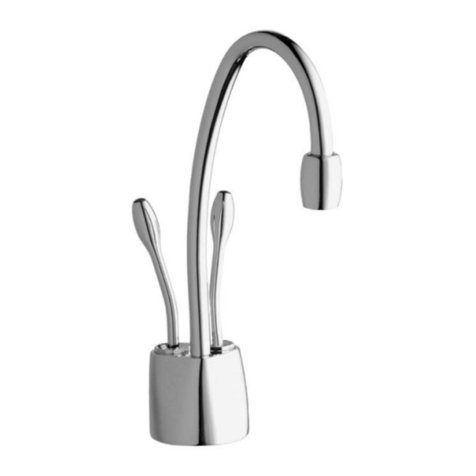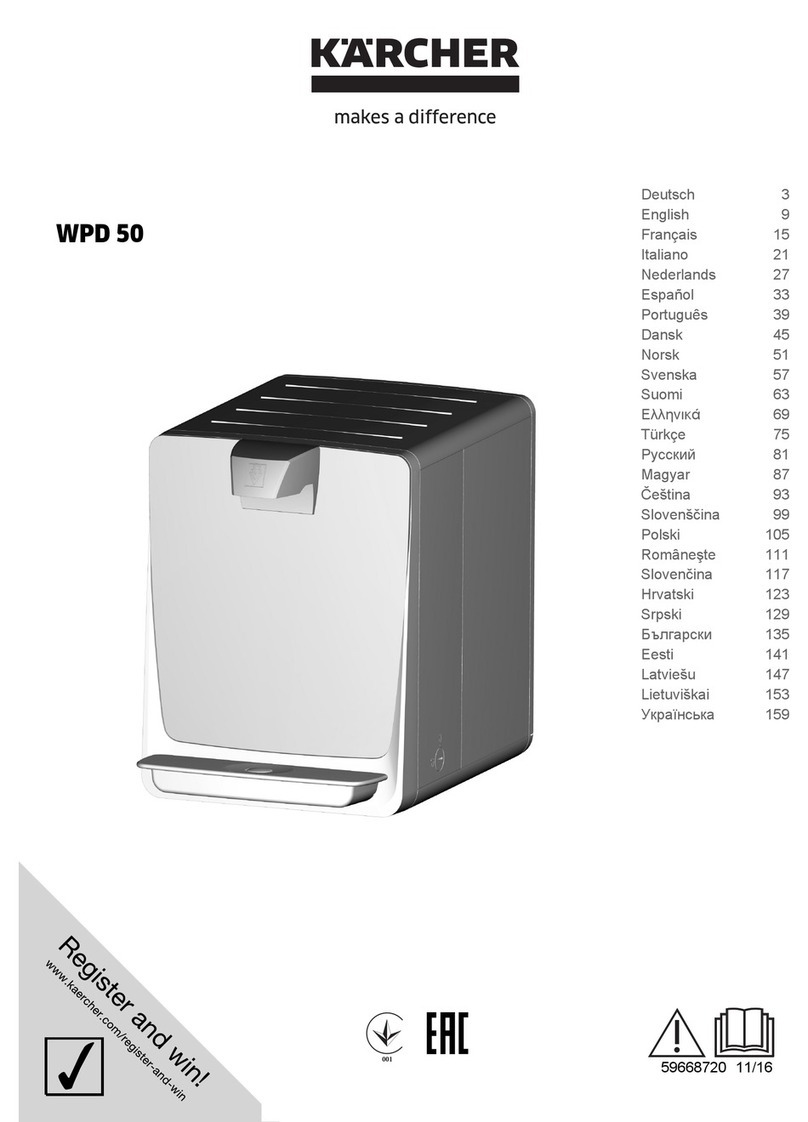Patriot Pro SXTi User manual

Patriot Pro SXTi
Service Manual
Revised 2019

Software Version 3.9a
Every day, thousands of billions of tons of water evaporate
from the earth's surface.
As the heat of the sun evaporates the water and draws it from the
earth's surface into the atmosphere, many impurities are left
behind. The water vapor eventually cools to form clouds and
then falls back to earth as precipitation.
On its way from the clouds to your faucet, soft rain water
dissolves and absorbs a part of almost everything it touches.
Falling rain cleans the air as it falls. Unfortunately the impurities that
were removed from the air have not left; they have just been relocated
through the water onto the ground.
These gases and other airborne contaminants can cause
undesirable tastes, colors and odors in water.
Rain falls onto the ground, collecting sediments like rust, sand and even algae. The water eventually finds its way
to a surface water supply or percolates downward and collects in an aquifer. As it percolates through the earth, the
water can absorb hardness minerals, iron, heavy metals, radioactivity, organic contaminants, and many other
complex elements and compounds.
Water can also collect numerous harmful man-made chemical impurities during this cycle. These synthetic
chemicals are generally odorless, colorless, and tasteless; and can sometimes be life-threatening. The statement,
"my parents drank this water for 75 years and it never hurt them", is no longer a valid excuse to not be concerned
with water quality. There has been a massive global increase in harmful chemical waste over the last 50 years.
The scientific and medical community has not had the time or budget to study the long-term health effects of the
more than 70,000 harmful chemicals that can be found in use today.
Approximately 1,000 new synthetic chemical compounds are entering the industrial marketplace each and every
year. Precipitation falls upon commercial and municipal dumpsites, toxic waste sites, industrial refuse depots,
military test sites, leach fields, mining operations, farmer’s fields etc... Where it dissolves minute amounts of the
toxic chemicals present and carries them along.
The United States Government estimated in 1986 that close to two percent of the nation's ground water supplies
were moderately polluted by sources such as hazardous waste dumps and leaking landfills.
Industrial wastewater is also a major source of water contamination. When certain chemicals come in contact with
others, they create new compounds. Chemicals that are considered generally acceptable in controlled amounts may
react with other elements and/or chemicals to form new compounds that could be highly carcinogenic.
Chlorine is one of the best-publicized examples; it reacts with organic matter in water and forms deadly
trihalomethanes.
Hard water is probably the single largest threat facing the American home in the 21st century. Hard water can coat
your family, your home and your appliances with thousands of pounds of inorganic mineral rock-scale each and
every year; hard water slowly destroys everything it touches. Left untreated, hard water costs you money, ruins your
lifestyle and can even lower the value of your home.
No one needs to tell you that you're living with Hard Water though. Soap doesn't lather easily, glasses are cloudy
after washing, a ring forms around the bathtub, faucets and shower heads are crusty, laundering results are poor and
there are many other easily recognized signs.

There are several degrees of water hardness. Even moderately hard, can seriously damage the plumbing system in
your home and, in time, cause inconvenient and expensive problems.
Hard water is a poor cleaner because it is loaded with a variety of impurities. These dissolved impurities react with
certain chemicals found in soap to form a gummy, insoluble curd.
This soap curd clings stubbornly to everything it touches. The ring around your bathtub is curd. That same curd
causes your hair to become dull and hard to manage.
Soap curd clogs skin pores and prevents your natural oils from moisturizing your skin. This dryness causes itching
and also aggravates skin conditions like psoriasis, eczema and acne.
Soap curd is especially noticeable by the scummy film it forms on dishes, glassware, walls and floors. Hardness
and other dissolved solids combine to form the residue you see as spots on glasses, crockery, cutlery and shower
enclosures.
Hard water harms fabrics
Laundry washed in hard water takes on a gray color and wears out faster than expected. With hard water in your
washing machine, it's almost impossible to wash clothes white - even when you use large amounts of detergent and
bleach Minerals and insoluble particles in hard water trap dirt and soap curd in the fabric of your clothes and linens.
These deposits give fabric a dull gray "washed-out" look and cause the clothing fibers to be brittle. Your clothes
and linens then feel harsh and rough - they deteriorate faster.
Hard water harms foods
Some vegetables such as peas and beans become tough and unpalatable when cooked in hard water. Baking with
hard water imparts an undesirable taste from the hardness minerals into your food. Tea, Coffee and other beverages
prepared with hard water taste awful and often contain flakes of hardness.

Hard water affects your house plumbing
Perhaps the greatest damage done by hard water is the damage that you can't easily see. Water heaters, humidifiers,
boilers and household pipes become lined with an increasingly thick layer of calcium and magnesium scale.
As this scale builds up, the water flow in your pipes diminishes to such a point that new piping is usually the only
realistic option to remedy the situation.
Hard water scale inside a water heater forms an insulating layer that prevents the burners or heating elements from
heating the water efficiently. Just 1/8" of scale inside the tank can require up to 30% more fuel to heat the water to
the desired temperature.
How water hardness is measured
Water hardness is measured in imperial Grains per Gallon (gpg). A grain, in this case, is the weight of an average
dry grain of wheat, approximately 1/7000th of a pound. The water treatment industry generally uses the following
standards to classify water hardness.
Soft Water
0 - 0.5 gpg
Slightly Hard Water
.5 - 3.5 gpg
Moderately Hard Water
3.5 - 7 gpg
Very Hard Water
7 - 10.5 gpg
Extremely Hard Water
10.5 gpg and greater

THE CRIMES OF HARD WATER, METALS & CHLORINE
Increased Water Heating Costs
Damaged Clothing
Excessive Soap Consumption
Pipe Scaling
Faucet and Fixture Damage
Skin Problems
Unpalatable Food
Undesirable Tastes and Odors
Premature Appliance Failure
Unsatisfactory Laundry Results
Unpleasant Tastes & Odors in Water
Staining on Faucets, Fixtures & Appliances

System Features & Benefits
By purchasing a Patriot Pro, you can now enjoy a clean, clear, softened water in your home while
minimizing salt, water and electrical consumption.
Efficient
Your Patriot Pro learns your lifestyle and adapts itself to meet your needs, delivering exceptional water quality
while saving you salt, water and electricity. The multimedia filtration bed not only softens your water and
removes metals, but also address chlorine tastes and odors.
Upgradeable
Designed for the future, your Patriot Pro is capable of being modularly upgraded, as new technologies are
developed to accommodate for rapidly degrading water conditions. The Evertech control center can be updated
with the latest software updates & upgrades as they become available.
Reliable
The mechanical subsystem in the Patriot Pro is revolutionary in its own right. The Patriot Pro is built around
Open-platformTM technology, building on a 40-year legacy of reliable design and using 21st century composite
materials to ensure reliable and dependable performance.
Safe
Every Patriot Pro is handcrafted in the USA by skilled artisans in a world-class facility to provide you with a
water treatment system that exceeds industry safety, manufacturing & quality control standards to give you peace
of mind.
Simple
Advanced manufacturing methods and skillfully crafted computer hardware & software makes the Patriot Pro
one of the easiest water softening systems to own and operate.
Fractional Brining
During normal regeneration cycles, your Patriot Pro only uses the exact amount of salt needed to match your
water usage history.
Built Tough
Your Patriot Pro is built tough to ensure a long service life.

Your responsibilities as an equipment owner
Your Patriot Pro is manufactured to be efficient and reliable. To ensure continued performance while keeping your
system operating within manufacturer’s specifications, the following operating conditions must be ensured by you, the
equipment owner/operator:
Water Pressure Regulator
The influent water pressure into this water system must be regulated by a code-compliant pressure-regulating device
not to exceed 75psi.
Power Protection
Power to this system must be supplied by an unswitched 110VAC supply. Surge protection is mandatory and is to be
supplied by you, the equipment owner. The use of a UPS (Uninterruptible Power Supply) is encouraged.
Salt
This water system uses either sodium or potassium salt to clean itself. The brine tank must be filled with a high quality
pellet or cubed salt to ensure system operation. Rock salt is usually not suitable for this system, as it can contain higher
levels of impurities that can require more frequent disinfection and can possibly even compromise system
functionality. Consult with your local water professional to decide on the best salt for your application.
Pur-Gard
The Pur-Gard injection feeder should be kept full to ensure proper system operation and maximum efficiency. Check
the level of your Pur-Gard feeder each time you fill your brine tank with salt.
Annual Cleaning and Disinfection
Bacteria can colonize water softeners through safe city water, salt, or even ambient air. While weekly antibacterial
rinses and supplementation with Pur-Gard help to minimize bacterial growth, your system should be cleaned and
disinfected on a regular schedule to ensure peak performance and protect the safety of you family. We can perform the
cleaning and disinfection service for you or you can purchase a comprehensive cleaning and disinfection kit to perform
this task yourself.
Periodic replacement of media
While built to the highest standards, certain media in your Patriot Pro will need to be replaced periodically.
Replacement intervals vary depending on your water chemistry and water consumption habits. Consult with your water
specialist during your annual inspection/tune-up service to ensure that you enjoy the very best water quality.

Pur-Gard
The Pur-GardTM system incorporated into every Patriot Pro ensures that you have the best water quality all year
long. This simple injection system is specially engineered to work in all climates to easily introduce Pur-Gard into
your brine tank while the system is waiting to clean itself.
Your Patriot Pro will use varying amounts of Pur-Gard, depending on your water consumption habits;
always maximizing efficiency and performance while providing you with the water quality that you deserve.
Pur-Gard is designed to:-
•Clean ion-exchange resin without damaging structured matrix media
•Create an inert protective coating on metallic moving parts
•Clean and lubricate all moving components
•Create an unhealthy environment for bacteria in the system
•Activate PurafeelTM technology on compatible systems
•Enhance self-sanitization process on compatible systems
Always keep your Pur-Gard reservoir full to ensure proper system performance, longevity & efficiency.

Cleaning and Disinfection
Your Patriot Pro is probably the hardest working appliance in your home, processing millions of gallons of
water over its service life and in turn protecting you from countless amounts of inorganic calcium,
magnesium, lead, copper, zinc, iron, manganese, and other contaminants that could be in your water.
In addition to capturing inorganic contaminants, your softener also accumulates sediment bacteria, algae, mold, and
fungus that can enter the system through safe city water, salt, or even from the air. These additional contaminants
slowly accumulate in your softener and can even colonize it with a biofilm of Heterotrophic Plate Count bacteria
(HPC). These bacteria are usually benign, but they can create afood base as safe refuge for potentially harmful
pathogens and seriously compromise the longevity and performance of your system.
Your system should be periodically cleaned and disinfected according to established protocol to ensure that it is
working to the best of its ability and to protect the safety of your family.

System Installation & Start-up Guidelines
Clear the installation area and carefully sweep the floor where the system will be installed.
Test home water pressure and make sure it is 30 –75 psi static. A code-compliant pressure regulator must
be installed to protect the system on all municipal water installations.
Check to confirm that the water heater has adequate heat expansion protection to protect the system from hot water
damage.
Install the system, drain and brine tank overflow according to prevailing local code.
Bypass System.
Run bathtub cold to purge piping of debris and chemical residue from installation,
This will take approx. 5 minutes at 3gpm.
Leave bathtub running and slowly open the inlet valve to the system.
Slowly open the outlet valve from the system.
Observe flow of water from the bathtub. Water will become a dark brown/black color. This color is caused
by the system disinfectant/preservative as well as dust from shipping & handling. Allow water to run until
clear. Observe water for particles. If resin particles are found in the water, bypass the system and call tech-
support. - Leave the bathtub running.
Program the system according to the programming instructions in this manual.
Begin a cleaning cycle by holding the recycle button for 3 seconds.
Advance the system through each cycle step by pressing the recycle button. Observe the system during
each cycle and then progressively advance to the next until the regeneration terminates.
Once the system has been advanced to normal operating mode, observe the flow of water from the bathtub
again for disinfectant and resin. Allow water to run clear –Turn off bathtub.
Test water at any softened faucet to confirm acceptable soft water production from the system.


Understanding Your Controller
Service Icon
Lit when the system is IN SERVICE and working normally
FLASHES when the system is going to clean at the designated
regeneration time
Programming Icon
Lit when the system is being programmed
Information Icon
Contact your local authorized service agent if this icon appears
Parameter Display
Displays current cycle step during regeneration
Data Display
During Service Mode—Displays Time of Day and capacity
remaining During cleaning mode—Counts remaining cycle time
PM Indicator
Lit when time being displayed is after noon and before midnight
Flow Indicator
Flashes when flow is detected in real-time Rate of flash
is proportional to rate of flow
X1000 Indicator
Lit when the data displayed must be multiplied by 1000
Extra Cycle Button
Press once to schedule a delayed cleaning Press and hold
to clean immediately
Up Button
Used to adjust settings
Down Button
Used to adjust settings

System Control & Operation
Your Patriot Pro SXTI System incorporates a highly sophisticated
microprocessor control system, making it efficient and reliable. All system
settings are pre-programmed at the factory and then carefully calibrated by
your installer for your specific application. Your Patriot Pro SXTI System
incorporates flash EEPROM memory and an innovative power backup system,
which means that your system programming should never have to be reset, even in
the event of an extended power outage.
In normal operating mode, the display shows the time of day and the
capacity remaining. The system observes your water usage through the
on-board flow meter and makes intelligent decisions on when and how
to clean based on its based programming profile and observations of
your water usage habits.
Cleaning mode
In cleaning mode the display shows the current cleaning cycle step and the
remaining time for that cycle to execute.
Flow meter
In service mode the display will show the time of day and remaining capacity;
the remaining capacity
counter counts backwards in gallons. By opening a faucet downstream
of the system, the correct functioning of the flow meter can be checked
by means of this counter.
Diagnostic Mode
In diagnostic mode the system will display various operational statistics
and diagnostic data.
Power-Failure Handling
In the event of a power failure, your system’s integrated Snapshot memory system
will retain all programmed data for an indefinite period of time. The system will
maintain the correct time of day during a period of several hours. In the case of a
prolonged power failure, the time of day might not be maintained; if this happens, the
time of day indication will, when the power supply is re-established, be flashing,
indicating that the time of day needs to be reset. All other programming is
unaffected.
Critical Software/Hardware failure
In the event of a critical software failure, the system display will be completely blank:
Call your local service provider for help.
Normal Operating Mode

Programming
End-user programming is generally not necessary. If
you ever need to change programming, the following
procedure should be used:
Programming instructions at the End-User
level Setting the Clock
Make sure that the system is in service mode Push and
hold the UP or DOWN button until the PROGRAMMING
ICON is lit Use the UP or DOWN button to set the
correct time of day
Press the EXTRA CYCLE button to save and exit
Accessing the End-User Programming level:
Make sure that the system is in the service mode.
Push and hold the UP and DOWN buttons for 5 seconds
Use the EXTRA CYCLE button to cycle through settings
Use the UP and DOWN arrows to make changes within individual settings.
Use the EXTRA CYCLE button to exit and return to service mode
Available programming parameters:
DO
Set the anti-bacterial day override setting—The system will cycle at least once
during the time interval set here. If you don’t use any water, the system will
not use any salt.
RT
The time at which the system will start its cycle on a designated cleaning day.
NOTE: This system fills the brine tank with soft water and then percolates for
3 hours. You can use water normally during the tank fill and percolation times.
H
Set the compensated hardness level. A compensated hardness level is the
amount of actual calcium hardness AND the amount of other reactive ions
in the water. Adjusting this setting will affect system capacity.
SF
This setting specifies what percentage of the system capacity will be held as a reserve. Since this
value is expressed as a percentage, any change to the unit capacity or feedwater hardness that
changes the calculated system capacity will result in a corresponding change to the reserve volume.
Default is set at 20.

Diagnostics Mode
Diagnostics mode is accessed as follows:
Press the UP and EXTRA CYCLE buttons together and hold them in
for at least 5 seconds Press the UP button to scroll through the data
Press the RECYCLE button to exit diagnostics mode
The following diagnostic data is available for viewing:
FR
FLOW RATE
Displays the current real-time flow rate through the system
PF
PEAK FLOW RATE
Displays the highest flow observed by the system since the last regeneration
HR
HOURS IN SERVICE
Displays the total number of hours that the system has been in service
VU
VOLUME USED
Displays the total volume of water treated by the system
RC
RESERVE CAPACITY
Displays the system’s current reserve capacity
SV
SOFTWARE VERSION
System Software/Firmware version
This can be upgraded by your local authorized service agent

Understanding how your system operates
Water Softening Process
The smallest units that make up chemical compounds and still retain the properties of
those compounds are called molecules. Molecules are made up of atoms or groups of
atoms. Electrically charged atoms are called ions. The charge of a single ion can be
either positive or negative - Ions of metals and of hydrogen are usually positively
charged and are called cations. Ions such as chlorine, nitrate, phosphate, fluoride
and sulfates are negatively charged and called anions.
Certain insoluble materials are made up of large ions forming a skeletal structure
containing oppositely charged ions. These ions can be exchanged with other similar ions
in an ion exchange.
The first commercial application of ion exchange was water softening in 1905. Since
then, ion exchange has been the most reliable method of softening and conditioning
water in homes and industry.
The Softening of water by ion exchange relies on the replacement of the calcium and
magnesium ions in the water by an equivalent number of sodium ions.
The Softening process may be illustrated by the following equation:
R2. Na +
Ca(HCO3)2 =
R2. Ca +
2NaHCO3
Sodium Ion Exchange Resin
Calcium Bicarbonate in water
Calcium Ion Exchange
Resin
Sodium Bicarbonate
in Water
Obviously, the system can only exchange a certain amount of hardness and other
contaminants before becoming exhausted. This is referred to as the capacity of the resin.
The capacity of the resin is referred to as grains of calcium carbonate hardness removed
per cubic foot of resin or Milliequivalents per liter. When the capacity has been
exhausted, the resin needs to be regenerated with a solution of sodium chloride (brine)
as follows:
Your Patriot Pro SXTI System can be regenerated with Potassium Chloride if
desired.
R2.Ca +
2NaCl =
2 R.Na +
CaCl2
Calcium Ion Exchange
Resin
Sodium Chloride Brine
Sodium Ion Exchange Resin
Calcium Chloride Waste
Over the years the composition of ion exchange media has advanced, reflecting
sophisticated global technological advances.
Ion exchange resins used in your Patriot Pro SXTI System are made in the USA,
without harmful toxic solvents.

Your system is designed to address certain impurities in your water through the
processes of ion exchange and physical filtration. Your system should only be
installed on water that is microbiologically safe. For optimum performance, and to
ensure complete warranty protection the Patriot Pro SXTI System should only
be installed when the following criteria are met:
Minimum
Maximum
Water Temperature
40 F
75 F
Water Pressure
30psi
80psi
Influent Water Hardness
0gpg
100gpg
Influent pH
6.7
8.7
Influent TDS
10 ppm
1000 ppm
Pathogenic Bacteria
0 CFU
0 CFU
Chlorine
0 ppm
1 ppm
Chloramine
0 ppm
1 ppm
Ambient Temperature
40 F
90 F
Evertech controller
Your Patriot Pro SXTI System is smart as a result of the exclusive Evertech control platform.
This advanced microprocessor control system incorporates the latest hardware and software to
ensure that your water is the very best that it can be. Your system can also be upgraded with
the latest software and hardware as they become available. See your authorized dealer for more
information.
During Service
The control center constantly monitors water usage in your home, learning your lifestyle and adapting
itself to ensure that you have a consistent supply of softened water.
The control center makes daily decisions about how and when it should clean itself using the latest
algorithms that consider your water usage habits, water hardness, and other programmed
parameters.
Your system will periodically perform an antibacterial deep cleaning. This cleaning cycle will occur
after a designated period of time (we recommend at least every once a week). This cleaning cycle will
inject Pur-Gard into your system and possibly even use salt to clean itself, depending on your water
usage. If you haven’t used any water during that interval, the system will not use any salt during
the antibacterial cleaning cycle.
During a Cleaning Cycle
Once your system determines that it needs to be cleaned, it will initiate a cleaning cycle. The cleaning
cycle is controlled by the Evertech control center and cycle times will vary depending on your water
usage habits, the system operational history, and other programmed parameters. You should try to
avoid using softened water during this time, particularly after the percolation cycle.

Second Backwash Your system rapidly discharges water upwards
through the resin media bed and to the drain.
You should not use water in the home during this
cycle step.
The cleaning sequence is as follows:
Once your system determines that it needs to perform a cleaning, it will initiate a
cleaning cycle at the preprogramed cleaning time (Normally 11pm). The cleaning
cycle is controlled by the Evertech control center and exact cycle times will vary
depending on your water usage habits.
At the completion of this sequence, the system will bring itself online & return to
normal operating mode.
Tank Fill Your system will add a calculated amount of soft water
to the salt tank, based upon your water usage history.
It is safe to use water in the home during this time.
Backwash Your system rapidly discharges water upwards
through the resin media bed and to the drain.
This backwash step ensures that trapped sediment
and broken resin beads are flushed out of the system
to minimize pressure loss and channelling.
You should not use water in the home during this
cycle step.
Brine and Slow Rinse Your system will extract brine water from the brine tank
and apply it to the ion exchange media.
Once the brine supply is exhausted, your system will
begin slowly rinsing contaminants through the media
bed and out of the tank to drain.
You should not use water in the home during this cycle
step.
Rapid Rinse Your system now reverses the flow of rinse water and
rapidly flows water downwards through the resin bed,
eliminating stray hardness or regenerate ions, and
filling the tank with softened water.
You should not use water in the home during this
cycle step.

Troubleshooting
These troubleshooting guidelines are not intended to be all-inclusive or to substitute
the expert diagnosis of your local Intermountain certified water professional.
Hard (untreated) water to service
Cause
Solution
Open or defective bypass
Close or verify bypass
Loss of resin
Refer to problem “Loss of resin”
System fails to regenerate
Refer to problem “System fails to clean”
Valve fails to draw brine
Refer to problem “Valve fails to draw brine”
Decreasing exchange capacity of resin
Clean, augment, or replace resin bed
No salt in brine tank
Add salt
Leak at riser tube
Verify that riser tube is seated correctly and is not damaged by
heat or high water pressure
Pur-Gard supply exhausted
Refill Pur-Gard feeder
System fails to clean
Cause
Solution
Faulty electrical supply
Verify electrical service – Confirm unswitched power outlet
Obstructed flow meter
Clean and/or replace flow meter
Damaged PCB
Replace PCB
Damaged drain motor
Replace drain motor

Softener fails to draw brine
Cause
Solution
Low operating pressure
Verify operating pressure; must exceed 30 psi static
Plugged injector
Clean injector
Plugged injector screen
Clean injector screen
Piston stuck in incorrect position
Inspect drivetrain and perform remedial action
Restricted/Obstructed drain line
Check drain line for kinks, restrictions or obstructions
Restricted/Obstructed brine line
Check brine line for kinks, restrictions or obstructions
Leak in brine line
Verify brine line and connections for air leakage
Insufficient water in brine tank
Refer to problem “Valve fails to refill brine tank”
Excessive water in brine tank
Cause
Solution
Valve fails to draw brine
Refer to problem “Softener fails to draw brine”
Improper brine refill time setting
Verify that brine refill time corresponds to the proper
salt level and amount of hydrolyte resin
Missing brine refill flow control
Verify that flow control is installed and properly sized
Leak from valve to brine tank
Clean or replace brine valve
Brine Valve damaged
Replace Brine Valve
Table of contents
Popular Water Dispenser manuals by other brands

Hamilton Beach
Hamilton Beach HBWC114-SSWH instruction manual
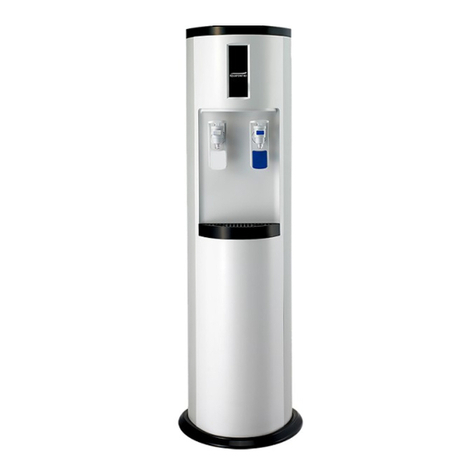
AAFIRST
AAFIRST AquaPoint 60 installation instructions

Follett
Follett 25CI400A Installation, operation and service manual
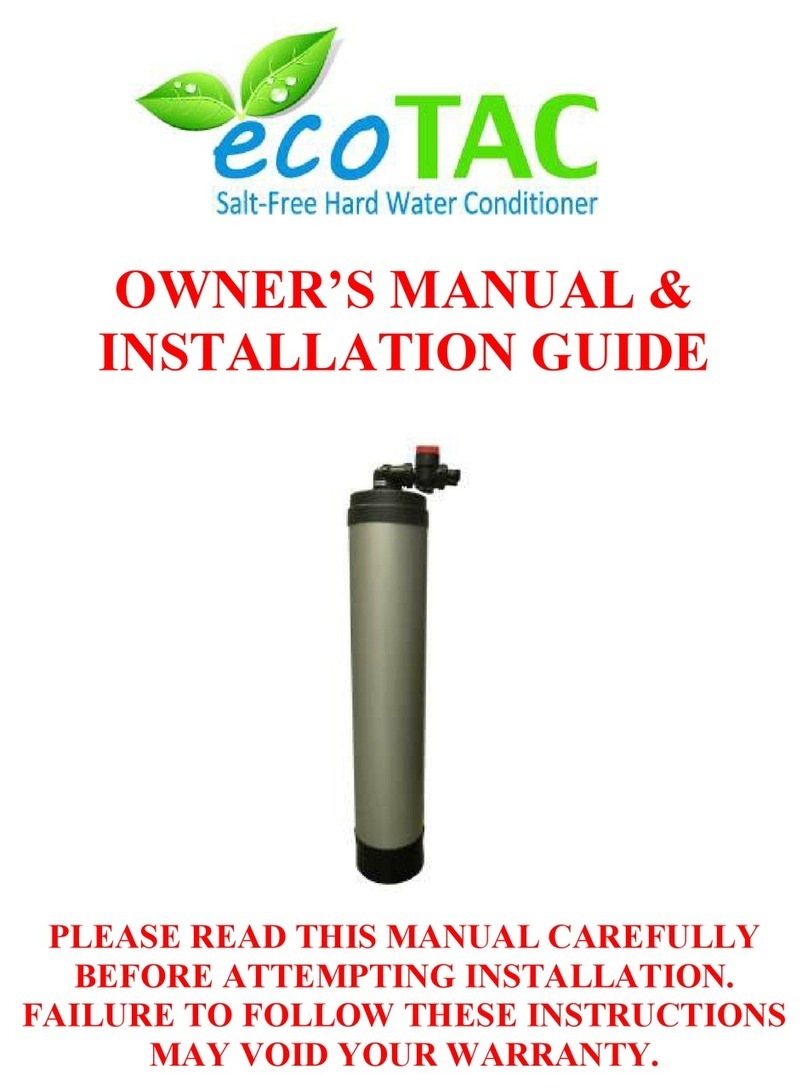
EcoTAC
EcoTAC Salt-Free Hard Water Conditioner installation guide
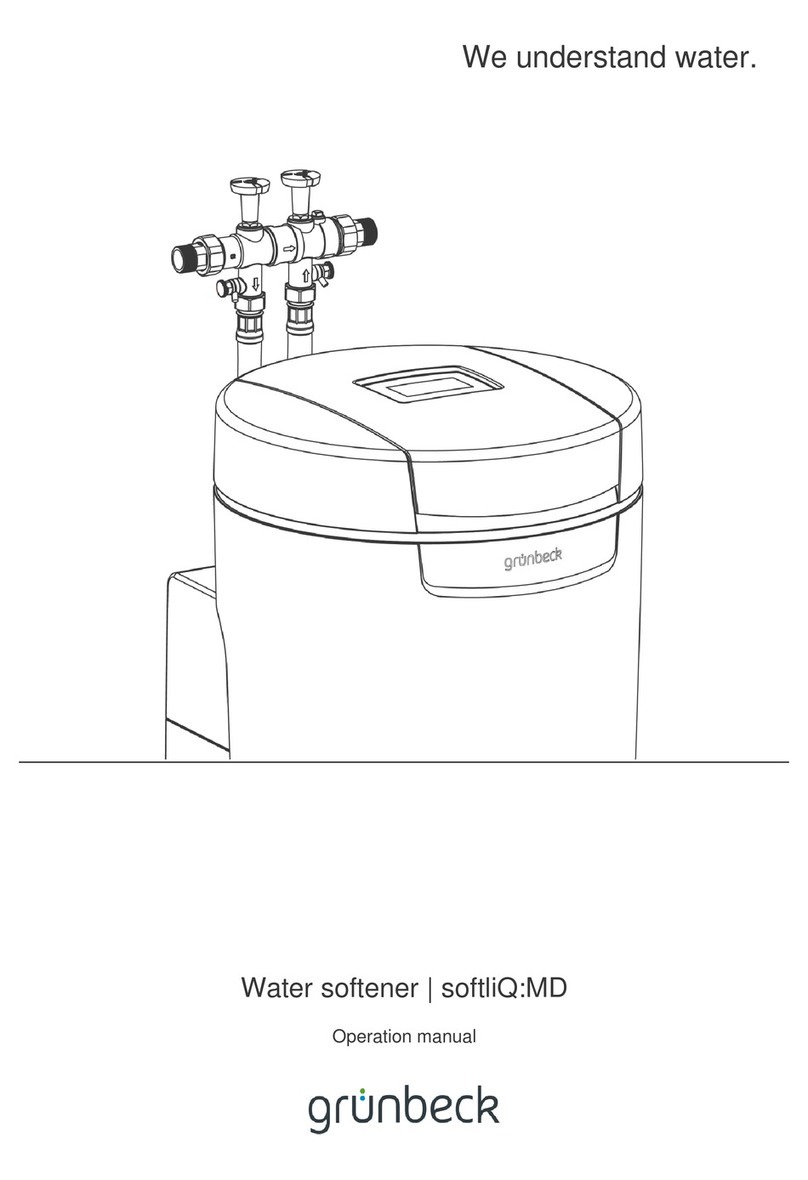
Grunbeck
Grunbeck softliQ:MD32 Operation manual

Elkay
Elkay LZSDWS 2F Series Installation, care & use manual

Hatco
Hatco ATMOSPHERIC AWD-12 Series Installation and operating manual
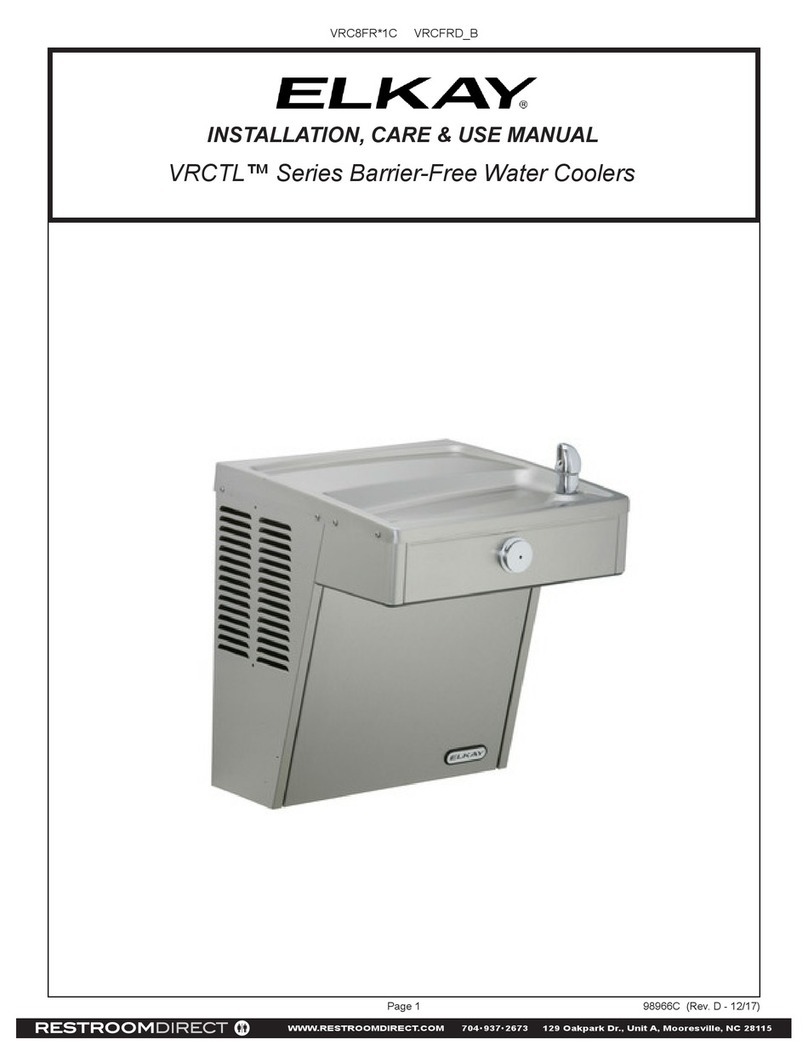
Elkay
Elkay VRCTL Series Installation, care & use manual

PUR
PUR P1QC7506BLS owner's manual
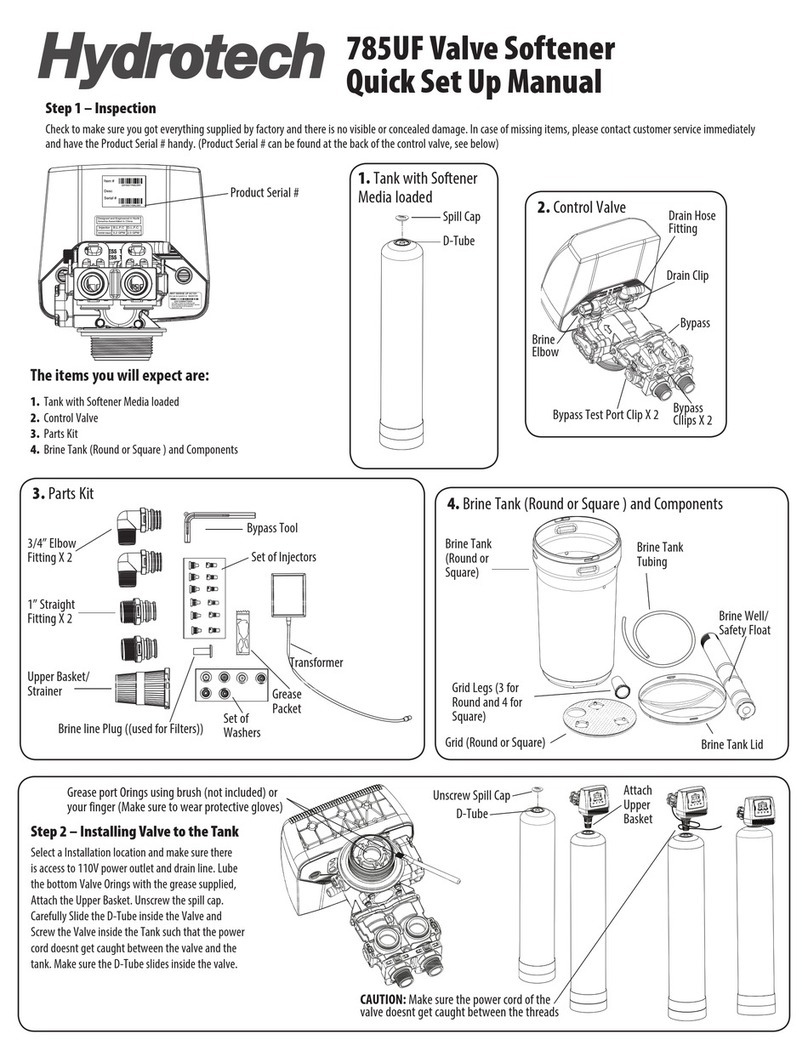
Hydrotech
Hydrotech 785UF Quick setup manual
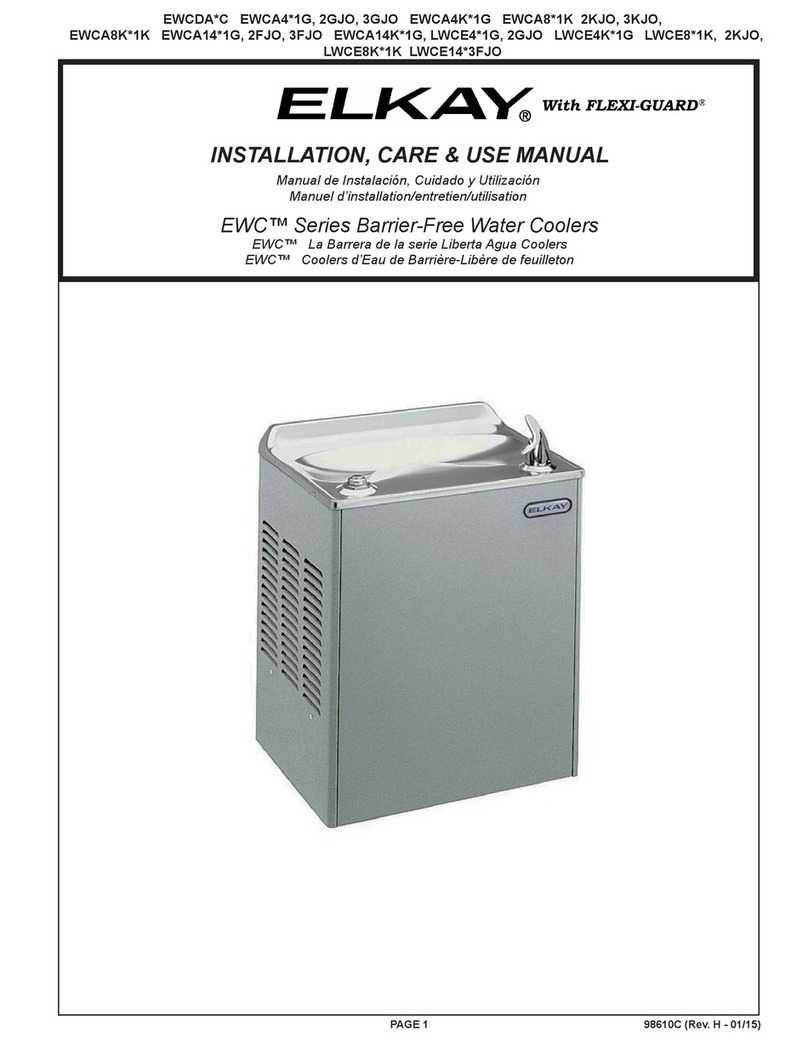
Elkay
Elkay EWCDA C Series Installation, care & use manual
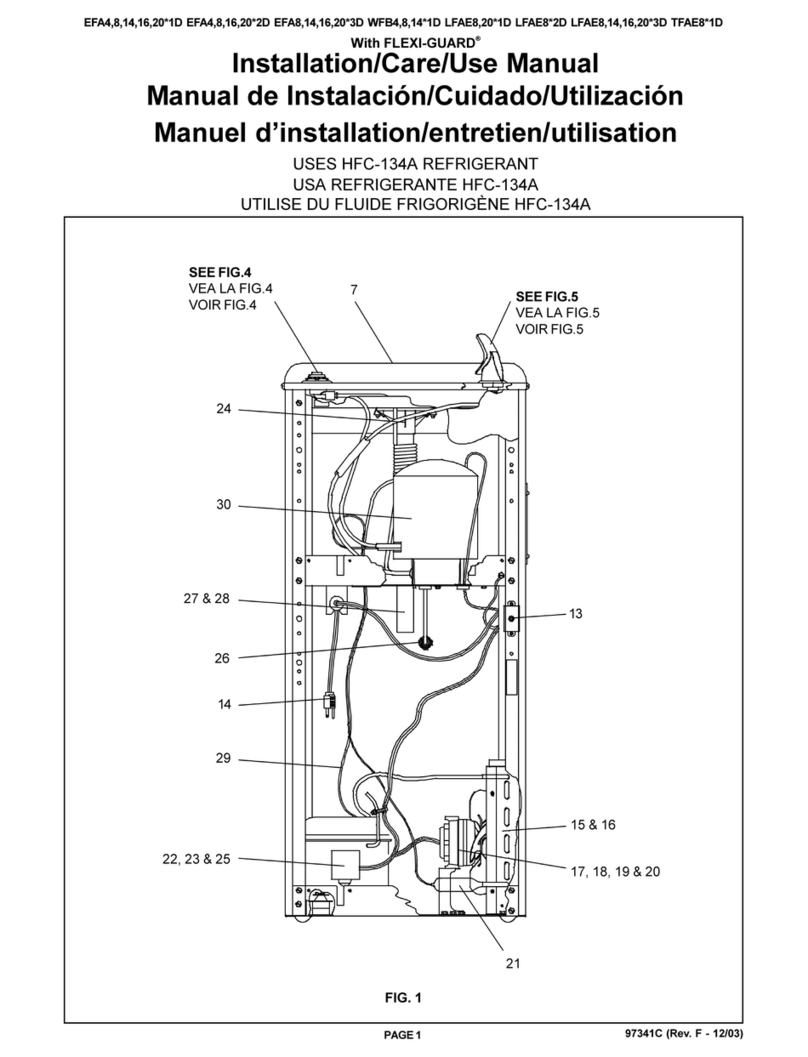
Elkay
Elkay EFA4 1D Series Installation, care & use manual

